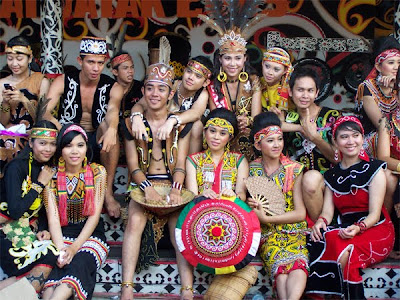Modern Concept
In the town areas without the longhouse concept, the homes of the Dayaks have an “Open House” concept; guests are served with food catered from outside or food cooked at home.
Christian Dayaks will attend church mass to give thanks for their good harvests. Gawai Dayak celebration may last for several days.
Since it was gazetted as a state public holiday, Gawai has been an annual festival held every June all over Sarawak. It shares a similar concept of “Open Houses” like the Chinese New Year and Hari Raya. Some Dayaks may go back to the longhouses while those who have migrated to the urban areas celebrate on a smaller scale.
This festival is a combination of merry making, feasting and drinking of rice wine.Beauty pageants has become very popular as part of the celebrations to display the priceless antique beads and the Iban maiden’s silver jewellery. 
Gawai today is not only acknowledged as a harvest festival but is celebrated like a New Year celebration, religious ritual and family reunion all at the same time. Some longhouses no longer practise the traditional way of gathering the folks together. 
In Kuching, celebrations start a week before with colourful street parades and cultural activities. On the eve of the Gawai, a grand state dinner is held at the Civic Centre with singing, dancing and a beauty pageant which culminates in the crowning of several Gawai Queens, one each for Iban, Bidayuh and Orang Ulu communities. 
Obviously, Gawai Dayak is the best and the most interesting time to visit Sarawak as you can see and sample the lifestyle and its festivities. All visitors are warmly received and accepted as new friends even if they happen to be strangers. It is a happy time for all concerned.

























